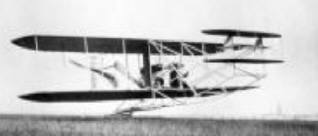 Return to
Return toAviation Answer-Man
Gateway
 Return to
Return to
Aviation Answer-Man
Gateway
 Return to
Return to
WHY SO MANY
GREAT PLANES Copyright 2002 by Richard Harris ROUGH DRAFT One of the enduring mysteries of general aviation is how the nation's sparsely-populated, rural Great Plains states -- particularly Kansas -- gave rise to so much of the leading-edge technology of general aviation. How, one wonders, did a bunch of sodbuster hicks and good ol' boys become the leaders in an industry that the Wright Brothers, Glen Curtiss and William P. Boeing somehow missed? The short, incomplete answer is "oil." Just about the time the airplane was invented, oil was discovered under the precious topsoil of Kansas, Oklahoma and Texas, and these states were suddenly saturated in oil money. But the oilfields were widely separated by distance, and many oil wells were far from the nearest roads, often with farmers' fence lines between them and the roads -- what few roads there were. While a spider's web of railroads and highways covered the coasts, the middle country was largely a challenge to traverse. In the 1920's the typical Model "T" automobile was scarcely able to manage 30 miles per hour on the few scattered, rutted dirt roads that meandered across the vast grasslands.
Nowhere was there more need for an airplane, nor more practical a place to fly one. The coastal states, with their mountain ranges, rocky hills, dense woodlands, and denser population clusters, offered scant places to land. Kansas, on the other hand, as one early aviator once put it, was "one big landing field" -- and so were the rest of the Great Plains. With vast distances to traverse to survey their far-flung empires, the newly-minted, free-spending oil barons -- many of them gutsy oilfield-roughnecks-turned-entrepreneurs -- were willing to take the wild risk of flying from oilfield to oilfield, giving them the ability to get richer quicker.
Eventually, a couple of successful wildcatters -- Jake Moellendick and Bily Burke -- would start a flying service with their planes. With their oil fortunes, they invested in building better airplanes -- not only for their flying service, but for the general aviation market -- inviting barnstormer/designer Matty Laird to Wichita to build his exceptional Laird Swallow. Clean and fast, with two passenger seats instead of one, the Swallow was the first practical and successful alternative to the cheap, slow, war-surplus Curtiss Jenny trainers that just about everyone flew in the 1920's. While there were other creative designs out there, Wichita oil money put the Laird Swallow on the market first.
Perhaps more important to the success of aviation in the midwest, though, were the people. While the coastal communities had evolved a culture of groupthink, so essential to the smooth functioning of an industrial society, and densely-packed urban areas, the Great Plains were populated with rugged individualists, farmers and ranchers, and pioneer entrepreneurs, who had come west on their own, or with their daring parents. They were the restless Americans who risked everything to stake their own claim to new land, and carve out a material subsistence from near-nothingness. The praire was a demanding home. Living on remote, desolate homesteads, the pioneer farmers of the 1870's and 1880's braved hostile, gunslinging cattlemen and outlaws, desperate, starving Indian raiders, rattlesnakes and wolf packs, tornadoes, floods, droughts, prairie wildfires and disease -- and terrible loneliness. Only the brave, hardy and resourceful stayed and survived. These were the ideal people to bring risky early American aviation to life. Their farm craftsmanship (every farmer was his own carpenter and mechanic) made them expert in creative woodworking and metalworking, and wise in the ways of basic machinery. And they were cheap. Used to making do on whatever Nature would provide, they did not waste anything. They were skilled at making the most of very little -- and at making things that lasted. "Use it up, wear it out, make do," was their motto, making them masters of efficient experimental designs and thrifty manufacturers of durable products. Used to the starvation "earnings" of tough, prairie farming, they willingly worked hard, cheaply, when given the chance to work in shops in town. In the 1920's on the East Coast and in the industrial Great Lakes areas, typically working folks were white-collar administrative workers, or unionized and immigrant labor. Many worked in bureaurcratic factories at simple, narrowly-defined tasks. By comparison, the prairie farmers were jack-of-all trades handy-men, mechanically-sophisticated, and nearly-all-English-speaking -- an ideal, trained, homogenous workforce for quick (albeit reckless) development of a complex idea. Already skilled in working with wood and metal on farm machinery, and used to the risks of working with heavy equipment, they were available for low wages and long hours. And there were plenty of them. Until 1920, most Americans lived on farms, growing their own most basic need -- food. Nowhere was farmland more plentiful than out on the Great Plains. In 1920, the population of the plains states was actually about the same as the population of the west coast. Also farm folks had few of the social and entertainment distractions of urban/urbane east-coast life to fill their free time. With time on their hands, tools and expertise at their fingertips, and lots of space to work, their creativity took wings. And they were led by optimistic, bullish entrepreneurs -- like Wichita's leading merchant, Walter P. Innes, Jr., who funded Travel Air and Stearman Aircraft. Used to the risky business of catering to Nature-dependent farmers, and bred from the eager stock of early pioneer entrepreneurs who sought their fortunes on the rowdy frontier, these businessmen were unhampered by the elaborate rituals, social and governmental rules, and collegial institutions of eastern business. Free to try anything, with anyone, anywhere, anytime, they were the great "boosters" who brought life and business to the prairie in any creative way they could find. So there you have it: Hardy, savvy pioneers, handy with tools and machines, with few distractions, funded by bold entrepreneurs and black gold -- and blessed with miles of landing space begging to be overflown -- found the airplane a perfect fit for their talents and their world. Not all were successes -- like the the first aircraft factory in the world built in Freedom, Kansas in 1900, which never built a flying machine, or the failed Call Aircraft Co. (not the cropduster maker) of Girard, Kansas, whose giant circus-tent-shaped 1908 flying machine never left the ground for more than a moment. Here, too, the helicopter was stillborn in Garden City, Kansas, where the underpowered 1909 Purvis-Wilson helicopter came close enough to earn the first patent ever for a rotary-wing aircraft, before running out of money. A half-century later, Kansan Charles Seibel's record-breaking Skyhook helicopter went farther, becoming the first aircraft to land on top of Pike's Peak, and was briefly built and sold by Cessna, but never really got a foothold in the market (Seibel later became a key engineer at Bell Helicopters). But enough plainsmen tried, hard enough, in American aviation's early years, that eventual success on the prairie was inevitable. When the nation's first successful commerical airplane company set up shop in Wichita, to build the Laird Swallow, its cadre of early airplane builders, and their early colleagues, had a great head start over others throughout the nation. They kept ahead for years, while spreading out from coast to coast, and generating great aircraft companies ranging from Ohio's Weaver Aircraft Co. ("WACO"), to a revived Lockheed in California. Their aircraft have legendary names: Laird, Swallow, Travel Air, Beech, Cessna, Stearman, Longren & Alexander, Lincoln & Roos, American Eagle, Weaver & WACO, Howard, Rearwin, Funk, Porterfield, and on and on. Curtiss-Wright bought factories here. In 1929, Al and Art Mooney set up shop in Wichita's old Burton Stock Car factory (the same old converted railroad-car factory which had brought Clyde Cessna to town, and had inaugurated Lloyd Stearman's company). Here they would build the Culver Cadet (the first popular light, light retractable), and ultimately their first "Mooney." Others would come and go, including a visiting metal-plane engineer named William B. Stout, who worked briefly on an unsuccessful attempt to build a stainless-steel monoplane across the road from Travel Air. He was more successful back home in Detroit with the Stout Metal Airplane Company, building a triple-engined airliner that became the legendary Ford TriMotor. In the war years to come, the Great Plains would become the perfect inland hiding place to move America's defense industries -- including aircraft factories -- well out-of-range of enemy attack. America's warplanes proliferated on the Great Plains as major factories of Boeing, North American, Consolidated, Douglas, Allison, and Pratt&Whitney sprung up. Consolidated's B-24 Liberator heavy bomber, the most numerous American aircraft of the war, was largely built at plants in Tulsa, Dallas and Ft. Worth, under various manufacturers. Kansas, alone, produced one out of every eight American military planes during the war, including over 40% of the nation's very heavy bombers, and a third of its medium bombers. In Kansas City, most of North American's B-25 Mitchell bombers were taking shape -- up to 13 a day. To the southwest, 150 miles, in Wichita, Boeing built most of the B-29 Superfortress bombers which would incinerate the cities of Japan. Cessna also built 750 troop-transport invasion gliders (towed behind transports to battle areas, and released, carrying a dozen soldiers each), and Kansas City's Commonwealth Aircraft built twice as many of them. Boeing-Wichita also built nearly all of the military's primary trainers (10,000+ Stearman Kaydets), while Cessna and Beech built the twin-engined advanced trainers which trained most of America's bomber crews. And at newly-created military air bases all across the plains, bombers were tested and their crews were trained -- probably about half of all U.S. heavy bomber crews -- many of them in bombers built on the Great Plains. After the war, the plains states' massive aviation-manufacturing over-capacity would give birth to Aero Commander, Helio, Bell Helicopter, General Dynamics, LTV (Ling-Temco-Vought) and LearJet -- and even short-lived factories for Piper, Bede (where a young chief engineer, Burt Rutan, helped develop the BD-5), and Italy's Piaggio Avanti pusher turboprop. Here, too, have been revivals of the the Great Lakes biplane, the Ercoupe and the Luscombe Sedan -- and the birth of countless homebuilts, kitplanes and ultralights. Today, aircraft-manufacturing remains one of the great industries of Oklahoma, Texas and the rest of the Great Plains. Employing as many as 60,000 Kansans at a time -- in aircraft, engine and avionics factories, maintenance shops, airlines, airports and Air Force bases, research centers and schools -- aviation is the second-biggest industry in Kansas, after agriculture. In Wichita, alone -- labeled by an early aviation trade organization as the "Air Capital" of the U.S. -- five major aircraft manufacturers (Boeing, Cessna, Raytheon, Bombardier/Learjet, and Airbus) and their local subcontractors, generally employ over 40,000 Wichitans. Nearby Augusta is home to the U.S. distributor (and assembler) of Australia's composite/canard Eagle 150B, and Strother field, a half hour south, is home to one of General Electric's main jet-engine facilities. No city on earth has built more of the world's airplanes -- over a quarter of a million flying machines since Clyde Cessna first put one together in the Burton Car Works factory, over 85 years ago. Of course, no one knows for sure exactly how many have been built in the Air Capital city, let alone in the rest of Kansas. And one can only wonder how many aircraft have been built across the Great Plains -- from Texas to North Dakota -- since Clyde Cessna became the first man to build and fly a plane on the Great Plains (near Enid, Oklahoma), over 90 years ago.
FROM THE GREAT PLAINS?
Last revised October 12, 2003